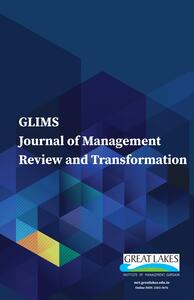
1 Department of Humanities and Social Sciences, Mahindra University, Hyderabad, Telangana, India
Creative Commons Non Commercial CC BY-NC: This article is distributed under the terms of the Creative Commons Attribution-NonCommercial 4.0 License (http://www.creativecommons.org/licenses/by-nc/4.0/) which permits non-Commercial use, reproduction and distribution of the work without further permission provided the original work is attributed.
This article aims to study the factors that influence non-conformists not to conform to group norms. In the literature about non-conformity, most of the discussion is on how non-conformists influence the world. The key factors contributing to non-conformity are not yet known. To investigate the factors, qualitative research study was used for a sample size of 20 participants with more than 5 years of work experience from various industries. In light of this possibility, this research uses a grounded theory approach to explore the factors that trigger non-conformists not to conform to group norms. This article lays a foundation for the motivation factors behind non-conformists. The study’s findings revealed 13 factors that emerged as the factors that trigger non-conformists not to conform to group norms.
non-conformity, groups, norms, non-conformist
Introduction
Throughout history, the advancement of human society has often relied on non-conformists who bring innovative and progressive ideas to their group (Grant, 2016; Sunstein, 2019; Wolf & Zuckerman, 2012). Unsurprisingly, non-conformists are often excluded, underappreciated and punished (e.g., Chudek & Henrich, 2011; Grant, 2016; Henrich & Henrich, 2007; Lewis & Sherman, 2010; Marques et al., 2001; Riesman et al., 1950; Tomasello, 2016). In his seminal work on conformity, Asch (1956) demonstrated that individuals may agree with majorities even under conditions where the majority favours an incorrect option. Such conformity has been explained by the individuals’ wish to meet the expectations of others, to avoid sanctions or even punishment for deviance, or to create a sense of belonging. Majority influence however is not only successful due to such normative pressures, but also because individuals accept high consensus as evidence about the ‘objective’ reality (Deutsch & Gerard, 1955) or as social proof (Cialdini, 1993). They agree with the majority position because high consensus serves as a cue to what is likely to be correct or, in other words, represents the ‘objective consensus’ (Mackie, 1987).
While Imhoff and Erb (2009) argue that uniqueness seeking blocks majority influence, there might be other factors contributing to non-conformity. Moreover, certain individuals challenge prevailing norms within the organisation by taking initiatives that lead to significant and impactful transformations. In this qualitative inquiry, the study aims to comprehend the motivating factors underlying non-conformists’ decision not to adhere to group norms.
Groups, Norms, Conformity and Non-conformity
Groups have been an important focus of many studies in literature. This is because of the recognition of the importance of groups as a relevant unit of analysis for the study of organisations.
In history, research on groups and group processes started in the 1930s when Sherif, Newcomb and Lewin started work on such varied topics as social norms, leadership and group decision-making (Cartwright & Zander, 1968). Further development of this happened in the late 1940s and 1950s on cooperation and competition, group structure, social power, conformity and group task performance and problem-solving (Paulus, 1980). The influence of groups on individual behaviour is now, perhaps, taken for granted.
Groups are composed of individuals. Groups have their own identity and characteristics, separate from the identity of their members. This implies that the individuals in a group exhibit behaviours, values, attitudes, or other identifiable patterns that are similar or acceptable to the other group members. This is referred to as ‘conformity’, and is an important construct necessary for the identification and categorisation of individuals into ‘Groups’, without ‘conformity’, it is difficult to think of groups.
Conformity is defined as ‘some behavioral or attitudinal change that occurs as a result of some real or imagined group pressure’ (Asch, 1952, as cited in Kiesler, 1969; Berg & Bass, 1961, as cited in Kiesler, 1969; Brown, 1965; Homans, 1961, as cited in Kiesler, 1969; Krech et al., 1962, as cited in Kiesler, 1969; Secord & Backman, 1964; Walker & Heyns, 1962).
Conformity is behaviour ‘intended to fulfill normative group expectations as these expectations are perceived by the individual’ (Wills, 1965, p. 376). On the contrary, non-conformity is ‘behavior which is intended to facilitate the attainment of some goal other than that of fulfilling perceived normative group expectations’ (Wills, 1965, p. 378).
Literature refers to this normative group expectation as a norm. Sherif (1936), as cited in McMahan and Kacmar (1991), defines norms as the ‘customs, traditions, rules, values, fashions, and any other criteria of conduct which are standardised as a consequence of contact with individuals’. Other scholars refer to norms as the ‘acceptable standards of behavior within a group that are shared by the group’s members’ (Robbins, 1989).
Norms can effectively control certain social situations as well as individual and group behaviours. While controlling these, norms also impact the environment of other individuals, in addition to impacting the enactment of the environment for an individual or group. The evolution and influence of norms have been established through various studies (Abrams et al., 2003; Asch, 1965; Back, 1965; Bartel & Saavedra, 2000; Coch & French, 1965; Festinger et al., 1965; Jetter et al., 2002; Sherif, 1965; Smith & Bell, 1994). The term ‘norms’ is generally used to refer to ‘group norms’, and ‘norms’ are supposed to be a group-level entity in the existing research (Bettenhausen & Murnighan, 1985; Feldman, 1984; Heywood & Aas, 1999; Hoffman, 1957; Kiesler, 1963; Munroe et al., 1999; Persson, 1976; Sanaria, 2004; Sheehan, 1979).
Based on the direction of the individual towards or against the group norms, individuals can be categorised into conformist individuals and non-conformist individuals. In general, conformist individuals are willing to conform to the organisational and group norms and practice more readily than non-conformist individual.
Methods
Procedures
To investigate and understand the factors that influence (conditions that trigger) non-conformists not to conform to group norms. More specifically, the study was aimed at analysing the underlying factors that affect non-conformists not to conform to group norms from an organisation point of view.
To understand the underlying reasoning of the non-conformist, we used qualitative research, particularly the grounded theory approach.
Sampling Procedure
Participants for the research study were chosen using purposive sampling as the goal of purposive sampling is to sample cases/participants strategically.
To explore the answers to the research question, an interview-based research study was conducted. The sample size for the study comprised 20 participants with more than 5 years of work experience, comprising of 16 males and 4 females. Demographics details of the participants are included in Table 1. Interviews were conducted at informal locations at the convenience of the interviewee. Interviews were conducted during the year 2017–2018. The researcher acted as an interviewer during the study.
Table 1. Demographic Details of Participants.
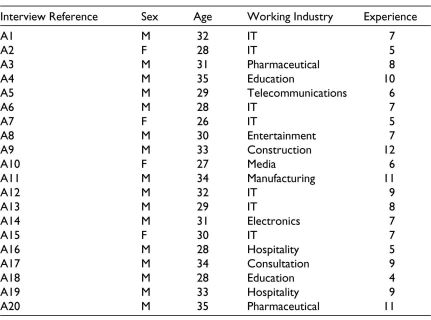
Source: The author.
This study aimed to gain a deeper understanding of participants’ views on factors that influence non-conformists not to conform to group norms. Corporate professionals from different industries are chosen for this study to ensure different perspectives are taken into consideration. So overall perspective or experience is considered. Thus, we attempted to design a study from which the results of a representative sample could be generalised to a larger population.
The same set of questions were asked in the same sequence to all respondents.
Interview Procedure
For the study, interviewees chose to complete the interview face-to-face or over the telephone, whichever was most convenient. Telephone interviews were used alongside face-to-face interviews on the well-defended assumption that both are valuable forms of collecting qualitative data (Cachia & Millward, 2011). One member of the research team carried out the interviews, which lasted approximately 30 min and were recorded to allow for verbatim transcription. Not all interviews were recorded; most of them were transcribed.
Interview Protocol
Interview questions were divided into two main sections:
Section 1: ‘Your perception/opinion,’ general, non-intrusive, questions such as: ‘In your own words, how would you describe non-conformist individuals.’
The purpose of the questions in this section was single fold, to ease the participant into the interview process (King, 2004).
Section 2: ‘Specific incident from an organisational point of view about non-conformist individual not conforming to group norms.
Section 3: What are the factors that influence non-conformists not to conform to group norms?
The purpose of the questions in this section was two-fold; first, to let the participant present the real-life experience and to understand the underlying reason/motive during the interview process (King, 2004).
Throughout the interview, open-ended questions were encouraged, and reflexive, descriptive, and lengthy answers were recorded.
During the process of interview analysis, many safeguards were taken to ensure that the results reflected the participant’s perspective. Following the phenomenological tradition, the epoch was sought through bracketing of personal knowledge and experience by categorising experiences into three different tables. In addition, the transcribed interviews were considered interpretive constructions (Kvale, 1996).
The rich interview material was then transcribed and evaluated by a second researcher (corporate professional) not involved in the present study who is familiar with the literature on non-conformity to maintain objectivity and avoid bias with qualitative data analysis.
Qualitative Analysis
Reliability and Validity
The first set of analyses investigated from the 20 transcribed interviews conducted were sufficient in providing a rich insight into our research question. One by one, the first 10 interviews resulted in a wealth of new themes. These themes were enriched and developed through the following interviews, and thematic saturation was reached around the 16th interview, as new themes did not appear after this point. This approach is supported by Kvale (1996), who noted that the number of interviews in current studies is generally around 15 ± 10.
Thus, transcription conventions that made the interview stay as ‘alive’ as possible and best conveyed the original interview situation were chosen. Rather than forcing the data into predetermined categories arising from the interview guide, we allowed thematic categories to develop out of the data. Furthermore, participants’ terms were used in the written interpretations and meaning condensations. Interpretation was carried out at the level of the informant’s self-understanding, and no attempt was made to find abstract meanings in participants’ statements.
During the process, we kept detailed field notes of impressions, questions and ideas and met weekly to discuss these ideas and detailed process journal.
During coding, to ensure that the interpretation of the data was reliable, three corporate professionals who have an understanding of the organisational behaviour literature were requested to examine and interpret the data to ensure reliability after discussions with the reviewer were complete, the researcher then conducted a final read of the data to determine that the codes represented were those that were a good fit for the data.
Data Analysis
The recursive analysis process was used by reading through all the transcripts to get a sense of the data as a whole. Codes and themes were developed during subsequent readings of transcripts. As emerging themes were developed, we reread transcripts to ensure that the codes and themes represented the whole of the data. The primary way in which reliability was enhanced was by carefully documenting all procedures.
The data collected were analysed first through an analysis of interview transcripts. During the stages of interview transcription and analysis, clear procedural guidelines were set up and followed for each interview. The interviews provided a sound basis for interpretation, as each interview is transcribed in the form of written communication making it possible to transcribe each interview verbatim.
For the qualitative analysis, we used the induction process by ‘the systematic examination of similarities within and across cases to develop concepts, ideas, or theories’ (Pascale, 2011, p. 53).
Many grounded theorists work with open coding in a process of ‘breaking down, examining, comparing, conceptualizing and categorizing data’ (Strauss & Corbin, 1990, p. 61).
Interview transcripts were analysed through the categorisation process proposed by the grounded theory approach (Glaser & Strauss, 1967). This inductive approach is quite similar to the qualitative content analysis process: emergence of relevant categories, development of a categorisation framework grounded in the data, reorganisation of this framework according to the information obtained, etc. The study by Charmaz (2011) makes clear that grounded theory is inductive at its core and will proceed with analysis by comparing data with data (developing codes), comparing data and codes (developing tentative categories), and developing categories into overarching concepts that are compared with (other) theoretical concepts.
In this study, the author of the article was involved in constructing the interview guide as well as in analysing and interpreting the statements.
At the end of the categorisation process, data from the transcriptions were classified into three specific categories based on the narrative of the story and emotion. The categorisation is presented in the following tables: Positive Emotion (Table 2), Negative Emotion (Table 3), and Neutral Emotion (Table 4). Consolidated codes from the three categories of emotions have been listed in Table 5, derived from the primary data conversion.
Stage 1: Conversion of Interview Material to Themes and Codes
Specific Incident Narrations
Table 2. Positive Emotion.
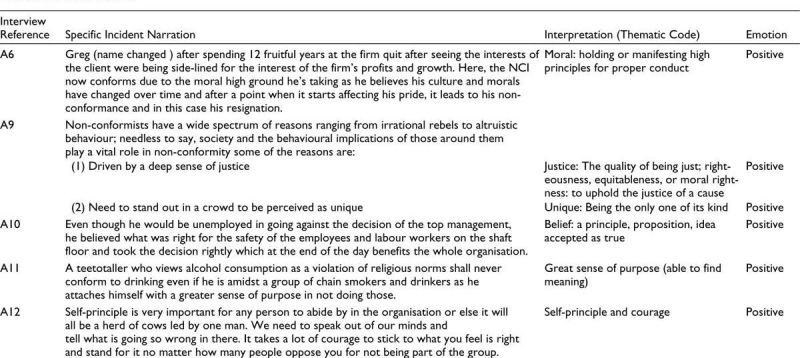

Source: The author.
Table 3. Negative Emotion.
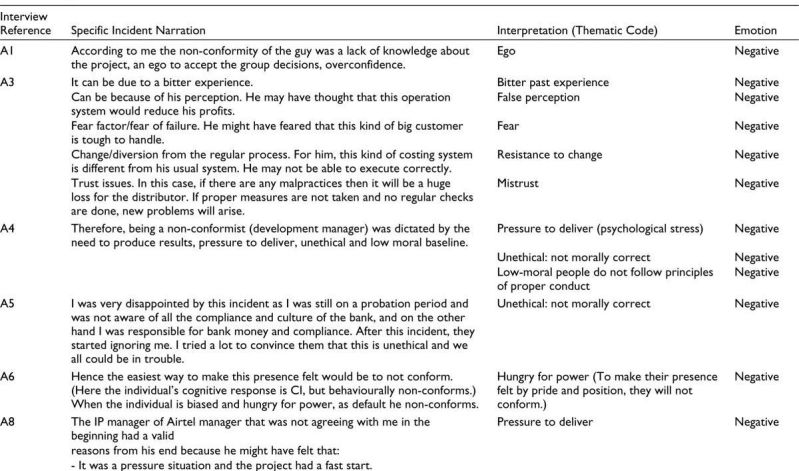
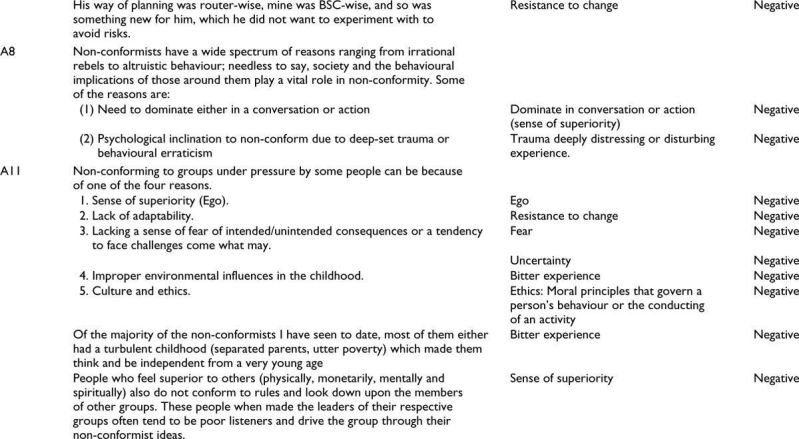
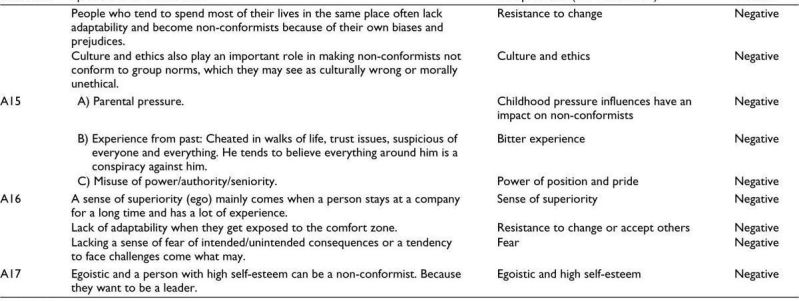
Source: The author.
Table 4. Neutral Emotion.
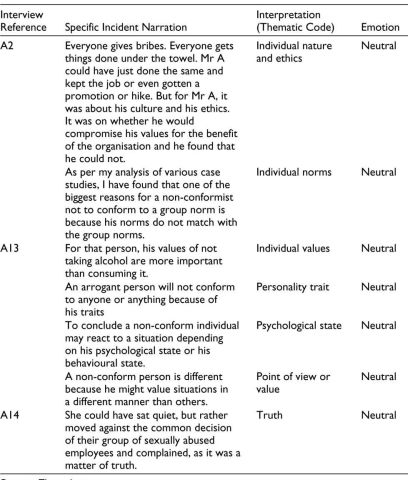
Source: The author.
Table 5. Consolidated Qualitative Themes, Tabulated by Emotions (Positive, Negative and Neutral).
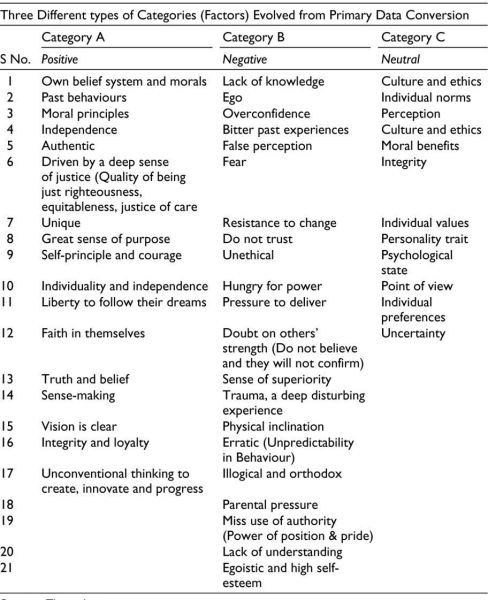
Source: The author.
The three categories are shown in the flow chart in Figure 1.
Figure 1. Classification of Nonconformity Story Narrations into Three Different Categories.
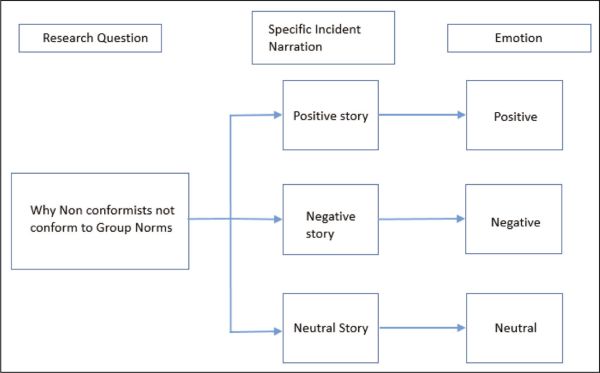
Source: The author.
Stage 2: Interpreting the Interview Recordings/Transcribed Interview with Three Corporate Professionals and the Factors Which they Consider the Factors of Non-conformity
In this study, the author requested three corporate professionals with prior work experience who understand the literature of the study to analyse the interview material to interpret the meaning and mention the code.
Overall, 100 codes were received from 3 corporate professionals.
Stage 3: Consolidating the Themes, Codes and Endorsement of Each Factor Developed by Three Corporate Professionals and a Researcher
After receiving the codes, three corporate professionals along with the researcher categorised how many times each factor is considered as the factor for non-conformity.
Table 6 shows the thematic groupings and top 13 endorsed factors of corporate professionals and authors.
Table 6. Top 13 Factors Emerged from Data Analysis.
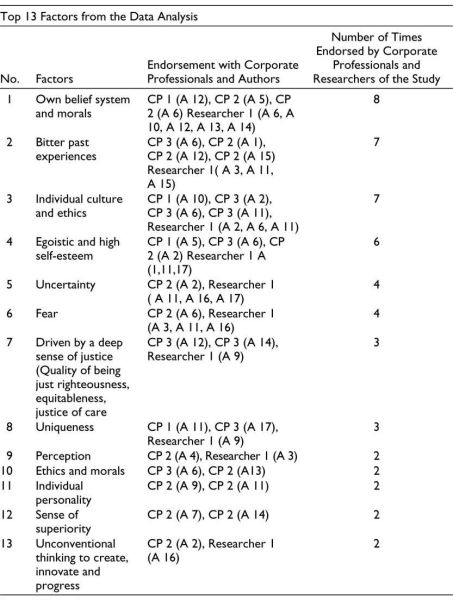
Source: The author.
Notes: CP: Corporate Professional (CP 1, CP 2, CP 3); A: Interview reference; Researcher: Author of the study.
Findings
Based on thorough qualitative inquiry using a grounded theory approach, this study found that three categories emerged from the data based on the experiences of the individual not to conform to group norms. The three categories are classified based on the emotions these individuals experienced when they encountered pressure to conform in the organisational context. The classification is based on positive, negative and neutral emotions (Tables 2–4). As discussed in the tables, first, the underlying motivation not to conform to group norms when individuals experience positive emotion is based on their belief system and moral principles; these individuals are driven by a deep sense of justice and a great sense of purpose and their unconventional thinking to create, innovate and progress propels them not to conform to group norms. These individuals have strong faith in themselves and dare to challenge the status quo and drive for positive change.
Second, when individuals experience negative emotions, they are less likely to conform to group groups. Data revealed that when individuals go through bitter past experiences they are hooked on their own emotions and hold false perceptions about the group practices and they are less likely to conform to group norms. These individuals do not trust and because of their egoistic nature and their lack of empathy to understand, these characteristics make these individuals less likely to conform to group norms.
Third, when individuals experience neutral emotions (neither positive nor negative), they may be less likely to conform because of the influence of culture and ethical practices one follows; these certainly can influence the way an individual thinks and acts and may lead to non-conformity with the group norms.
Finally, the researcher along with three corporate professionals analysed the data and marked the codes based on the analysis, and after analysis 13 key factors have been ranked based on their repeated mention of the reason for non-conformity. Among several factors why individuals do not conform to group norms presented in Tables 2–4, factors presented in Table 6 are the key factors that lead to non-conformity.
These findings will hopefully aid in future theory building and development of non-conformity, non-conformists and organisation transformation.
Practical Implications
In organisations, decision-making at the individual level/group level is important to achieve a goal. Few individuals conform and few others do not. In a few instances, the non-conformist viewpoint is abandoned and considered of the least importance; however, individuals who raise voice are turned to bring about constructive change in the organisation (Van Dyne & LePine, 1998). On the one hand, it is important for human resource managers, Supervisor/Group members, to conduct regular organisational culture and climate audits to understand employees’ perceptions of socially acceptable behaviours.
Analysing their viewpoints and underlying reasons for non-conformity can help the organisation at a group level. If the underlying factor for non-conformity is due to unconventional thinking and desire to grow and innovate, a Sense of purpose for the greater good, and holding moral values/Ethical values which play vital role for the positive organisational change.
This in turn helps for the growth of the Individual and positively contributes to the group. Organisations will also benefit from increasing their innovation levels. Innovation is mainly driven by non-conformists, who defy the existing practices and Norms, envision a different solution from the status quo and successfully implement a new solution despite all the resistance from existing vested interests in the organisation. This article helps novice leaders understand their own and others’ motivations for non-conformance and the factors influencing their behaviours. This provides a useful approach to dealing with non-conformist individuals to achieve desirable results in the organisation. This article is also relevant for entrepreneurs as well as social and political leaders. This article categorises, integrates, and extends our knowledge about non-conformists. This is useful for future researchers and practitioners to identify knowledge gaps and address organisational transformational challenges.
Conclusion
Non-conformity is important because it can profoundly impact the organisation and its members. Although numerous research studies have investigated the impact of non-conformity on groups and organisations, the underlying factors that lead to non-conformity are unclear. In particular, this article identifies certain underlying factors for non-conformity to bring about a positive change in organisations, for example, factors such as good intentions to create, to innovate, a sense of purpose for the greater good, appreciation of individual uniqueness and considering moral and ethical values. Second, non-conformity can also occur because of the sense of superiority, ego and false beliefs, which would then have negative effects on the growth of the organisation. This study provides factors leading to non-conformity in organisations by identifying new lines of inquiry and providing important managerial insights into effectively managing workplace norms, a highly important and relevant topic for organisations today. Hope this article will help inspire more valuable and critical research to better understand how non-conformity impacts in different organisational contexts and how organisations respond to non-conformity to foster a better workplace with more effective people and performance.
Future Recommendations
Future studies can consider how the above-mentioned 13 individual variables affect non-conformity at various instances at the organisational level and its impact at a group and individual level. Future work should examine how these factors impact various industries. Future research could enhance the article’s scope by better understanding non-conformity factors in a different context. Finally, future works investigating these paths will deepen our understanding of non-conformity, and would also open new research avenues.
Limitations
The qualitative research relies on the interpretation of researcher, which introduces subjectivity and the potential for bias. While efforts have been made to mitigate subjectivity bias, it is possible that some level of subjectivity bias remains in the study.
Declaration of Conflicting Interests
The author declared no potential conflicts of interest with respect to the research, authorship, and/or publication of this article.
Funding
The author received no financial support for the research, authorship, and/or publication of this article.
Appendix A
Interview Protocol, Follow-up Session
The following questions were posed to the interviewee:
Question 1. ‘Your perception/opinion’, general, nonintrusive, questions such as: ‘In your own words, how would you describe non-conformist individuals?’
Question 2. ‘Specific incident from an organisational point of view about non-conformist individual not conforming to group norms.’
Question 3. What are the factors that influence non-conformists not to conform to group norms?
Abrams, D., Rutland, A., Cameron, L., & Marques, J. M. (2003). The development of subjective group dynamics: When in-group bias gets specific. British Journal of Developmental Psychology, 21, 155–176.
Asch, S. E. (1952). Social psychology. Prentice-Hall.
Asch, S. E. (1956). Studies of independence and conformity: I. A minority of one against a unanimous majority. Psychological Monographs, 70, 1–70.
Asch, S. E. (1965). Effects of group pressure upon the modification and distortion of judgements. In H. Proshansky & B. Seidenberg (Eds.), Basic studies in social psychology (pp. 393–401). Holt, Rinehart & Winston, Inc.
Back, K. W. (1965). Influence through social communication. In H. Proshansky & B. Seidenberg (Eds.), Basic studies in social psychology (pp. 411–423). Holt, Rinehart & Winston, Inc.
Bartel, C. A., & Saavedra, R. (2000). The collective construction of work group moods. Administrative Science Quarterly, 45, 197–231.
Berg, I. A., & Bass, B. M. (1961). Conformity and deviation. Harper & Row.
Bettenhausen, K., & Murnighan, J. K. (1985). The emergence of norms in competitive decision-making groups. Administrative Science Quarterly, 30, 350–372.
Brown, R. (1965). Social psychology. The Free Press.
Cachia, M., & Millward, L. (2011). The telephone medium and semistructured interviews: A complementary fit. Qualitative Research in Organizations and Management, 6(3), 265–277. https://doi.org/10.1108/17465641111188420
Cartwright, D., & Zander, A. (Eds.). (1968). The nature of group cohesiveness. In Group dynamics: Research and theory (3rd ed., pp. 91–109) Harper & Row.
Charmaz, K. (2011). Grounded theory methods in social justice research. In The Sage handbook of qualitative research (pp. 359–380). Sage Publications.
Chudek, M., & Henrich, J. (2011). Culture–gene coevolution, norm-psychology, and the emergence of human prosociality. Trends in Cognitive Sciences, 15(5), 218–226.
Cialdini, R. B. (1993). Influence—Science and practice. HarperCollins Publishers.
Coch, L., French, J. R. P., Jr., & John, R. P. (1965). Overcoming resistance to change. In H. Proshansky & B. Seidenberg (Eds.), Basic studies in social psychology (pp. 444–460). Holt, Rinehart & Winston, Inc.
Deutsch, M., & Gerard, H. B. (1955). A study of normative and informational social influences upon individual judgment. Journal of Abnormal and Social Psychology, 51, 629–636.
Feldman, D. C. (1984). The development and enforcement of group norms. Academy of Management Review, 9(1), 47–53.
Festinger, L., Schachter, S., & Back, K. (1965). The operation of group standards. In H. Proshansky & B. Seidenberg (Eds.), Basic studies in social psychology (pp. 471–485). Holt, Rinehart & Winston, Inc.
Glaser, B. G., & Strauss, A. (1967). The discovery of grounded theory: Strategies for qualitative research. Aldine Publishing Company.
Grant, A. (2016). Originals: How non-conformists move the world. Penguin Books.
Henrich, N., & Henrich, J. (2007). Why humans cooperate: A cultural and evolutionary explanation. Oxford University Press.
Heywood, J. L., & Aas, O. (1999). Social norms and encounter preferences for cross country skiing with dogs in Norway. Leisure Sciences, 21(2), 133–144.
Hoffman, M. L. (1957, June). Conformity as a defense mechanism and a form of resistance to genuine group influence. Journal of Personality, 25(4), 412–424.
Homans, G. C. (1961). Social behavior: Its elementary forms. Harcourt, Brace & World.
Hornsey, M. J., Majkut, L., Terry, D., & Mckimmie, B. M. (2003). On being loud and proud: Non-conformity and counterconformity to group norms. British Journal of Social Psychology, 42, 319–335.
Imhoff, R., & Erb, H. P. (2009). What motivates nonconformity? Uniqueness seeking blocks majority influence. Personality and Social Psychology Bulletin, 35(3), 309–320.
Jetten, J., Postmes, T., & Mcauliffe, B. J. (2002). ‘We’re all individuals’: Group norms of individualism and collectivism, levels of identification and identity threat. European Journal of Social Psychology, 32, 189–207.
Kiesler, C. A. (1963, December). Attraction to the group and conformity to group norms. Journal of Personality, 31(4), 559–569.
Kiesler, C. A. (1969). Group pressure and conformity. In J. Mills (Ed.), Experimental social psychology (pp. 233–306). Macmillan.
King, N. (2004). Using templates in the thematic analysis of text. In C. Cassels & G. Symon (Eds.), Essential guide to qualitative methods in organizational research (pp. 256–270). Sage Publications.
Krech, D., Crutchfield, R. S., & Ballachey, E. L. (1962). Individual in society. McGraw-Hill.
Kvale, S. (1996). Interview views: An introduction to qualitative research interviewing. Sage Publications.
Lewis, A. C., & Sherman, S. J. (2010). Perceived entitativity and the black-sheep effect: When will we denigrate negative ingroup members? Journal of Social Psychology, 150, 211–225.
Mackie, D. M. (1987). Systematic and nonsystematic processing of majority and minority persuasive communications. Journal of Personality and Social Psychology, 53, 41–52.
Marques, J., Abrams, D., & Ser.png) dio, R. G. (2001). Being better by being right: Subjective group dynamics and derogation of in-group deviants when generic norms are undermined. Journal of Personality and Social Psychology, 81, 436–447. https://doi.org/ 10.1037/0022-3514.81.3.436
dio, R. G. (2001). Being better by being right: Subjective group dynamics and derogation of in-group deviants when generic norms are undermined. Journal of Personality and Social Psychology, 81, 436–447. https://doi.org/ 10.1037/0022-3514.81.3.436
McMahan, G. C., & Kacmar, K. M. (1991) The diagnosis of work group norms: Practical implications for change. Journal of Organizational Change Management, 4(4), 24–33.
Munroe, K., Estabrooks, P., Dennis, P., & Carron, A. (1999). A phenomenological analysis of group norms in sport teams. Sport Psychologist, 13(2), 171–182.
Pascale, C.-M. (2011). Cartographies of knowledge: Exploring qualitative epistemologies. Sage Publications.
Paulus, P. B. (Ed.). (1980). Psychology of group influence. Lawrence Erlbaum Associates, Inc.
Persson, L. N. (1976). Social stratification and industrial employment. Industrial Management, 18(November–December), 21–24.
Riesman, D., Glazer, N., & Denney, R. (1950). The lonely crowd: A study of the changing American character. Yale University Press.
Robbins, S. P. (1989). Organizational behavior: Concepts, controversies, and applications. Prentice-Hall of India.
Sanaria, A., S. (2004). Conformity and norms: The individual perspective [Conference session]. Asia Academy of Management (AAOM) conference, Shanghai, China, December 16–18.
Secord, P. F., & Backman, C. W. (1964). Social psychology. McGraw-Hill.
Sheehan, J. J. (1979). Conformity before the emergence of a group norm. Journal of Psychology, 103, 121–127.
Sherif, M. (1936). The psychology of social norms (pp. 3–24). Harper & Brothers, as cited in McMahan, Gary, C., & Kacmar, K. M. (1991). The diagnosis of work group norms: Practical implications for change. Journal of Organizational Change Management, 4(4), 24–33.
Sherif, M. (1965). Formation of social norms: The experimental paradigm. In H. Proshansky & B. Seidenberg (Eds.), Basic studies in Social Psychology (p. 461–471)Holt, Rinehart & Winston, Inc.
Smith, J. M., & Bell, P. A. (1994). Conformity as a determinant of behaviour in a resource dilemma. Journal of Social Psychology, 134(2), 191–200.
Strauss, A., & Corbin, J. (1990). Basics of qualitative research. Sage Publications.
Sunstein, C. R. (2019). Conformity: The power of social influences. New York University Press.
Tomasello, M. (2016). A natural history of human morality. Harvard University Press.
Van Dyne, L., & LePine, J. A. (1998). Helping and voice extra-role behaviours: Evidence of construct and predictive validity. Academy of Management Journal, 41(1), 108–119. https://doi.org/10.2307/256902
Walker, E. L., & Heyns, R. W. (1962). An anatomy for conformity. Prentice-Hall.
Willis, R. H. (1965). Conformity, independence, and anticonformity. Human Relations, 18(4), 373–388. https://doi.org/10.1177/001872676501800406
Wolf, B., & Zuckerman, P. (2012). Deviant heroes: Nonconformists as agents of justice and social change. Deviant Behavior, 33(8), 639–654.